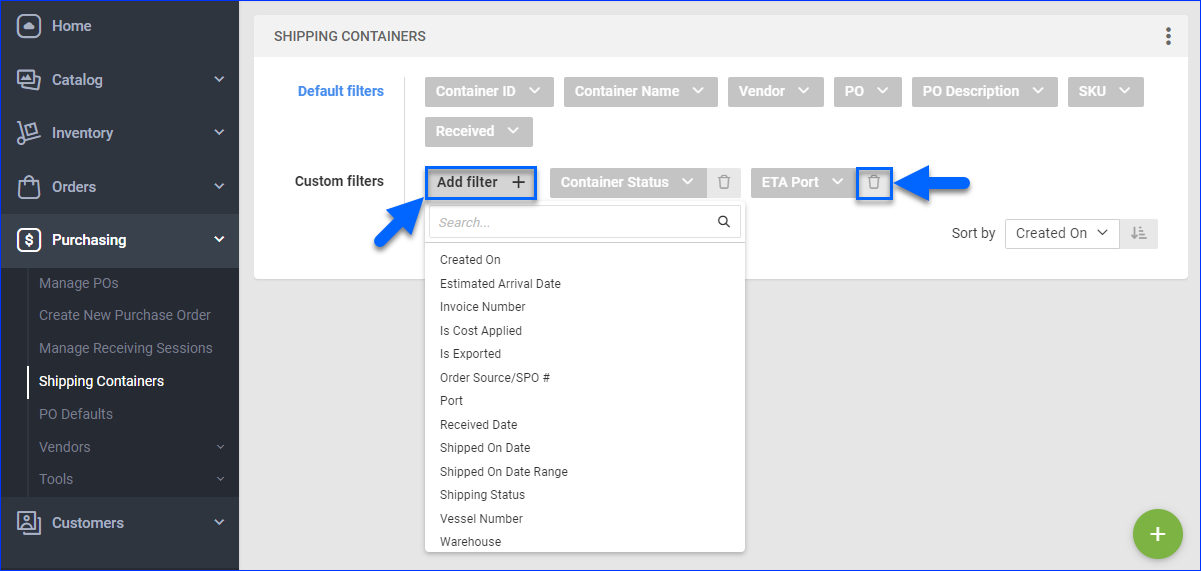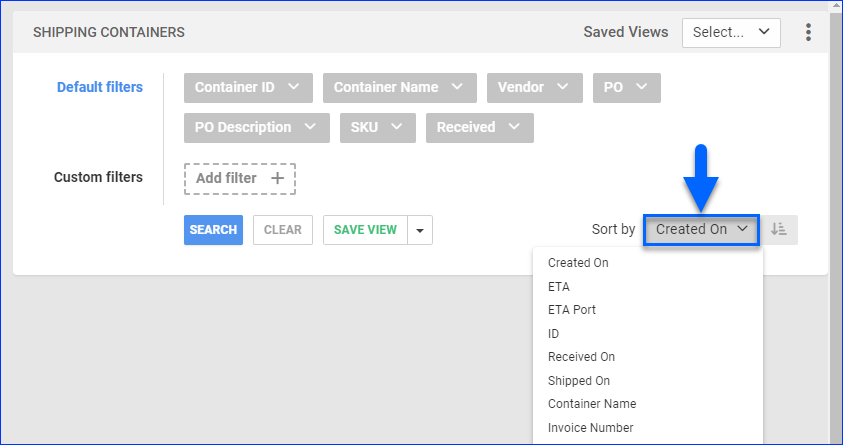Overview
The Manage Shipping Containers page in Sellercloud gives you quick and easy access to all your Shipping Containers. On this page, you can:
- View all shipping containers in your Sellercloud account
- Use search filters to show only specific containers
- Save your filters to effortlessly repeat searches
- Sort the list of containers based on different columns
- Show or hide data columns from the list
- Perform individual and bulk actions related to containers
Page Overview
To access your shipping containers, go to Purchasing > Shipping Containers.
There are three components to the Manage Shipping Containers page:
- Search Filters – Search criteria used to get specific results. You can save searches for repeat use.
- Search Results – A list of containers matching your search filters. You can sort it differently and show or hide data columns.
- Actions – Actions related to shipping containers.
Search Filters
Filters offer multiple-choice selection lists or allow you to enter specific values. Your choices build on each other. Each subsequent choice narrows the scope of your search results further and affects what the page displays. You can add as many filters as you like or none at all.
There are Default filters that are always displayed and Custom filters that you can display manually by clicking the Add filter button and selecting a filter from the list. To remove a custom filter from the page, click the Trash icon next to it.
After you click Search, each filter you apply gets highlighted in orange or green. If a filter is gray or not displayed at all, it’s not active. You can add or remove filters and search again at any time.
Once you have set up your filters, you can click Save View to save the search. Then, you can repeat the same search by selecting it from the Saved Views menu on the top right.
Search Results
The search results display a list of shipping containers matching your search criteria, with data columns showing various container details.
You can add, remove, and even reorder data columns. To do so, click the three dots icon at the top right and select Customize Columns.
Now you can:
- Reorder columns by dragging them vertically in the list
- Hide columns by clicking the Trash icons
- Add columns by clicking Add column
You can also sort the shipping containers list in a different order based on a specific column using the Sort by drop-down menu.
Actions
The Manage Shipping Containers page also has actions for container management.
The Actions icon is located on the bottom right of the page. By default, it is a green plus icon that allows you to create a new shipping container. When you select containers from the search results by checking the boxes to their left, the icon turns blue. Once it’s blue, you can click it to manage all selected containers.
You can use the search to find a specific action quickly. Click the Star icon next to any frequently used action to pin it to the top of the actions list for quick access.
Some of these actions will display a notification at the bottom of the screen when used, telling you that a Queued Job has been created. You can click the link to the queued job to view it. Make sure to refresh the page to update the job’s Status.
Descriptions
This section lists and defines all available elements on the Manage Shipping Containers page. This includes the search filters, the columns that display container data and let you sort results and the actions you can perform on selected containers.
Filter Descriptions
See the following tables for all Default/Custom filters and their descriptions.
Default Filters
| Filter | Description |
| Container ID | Show only specific shipping containers by their unique Container ID. |
| Container Name | Show only specific containers by Container Name. |
| Vendor | Show only containers with POs from one or more specific Vendors. |
| PO | Show only containers with specific POs, searching by PO ID. |
| PO Description | Show only containers with specific text in their description. |
| SKU | Show only containers with one or more specific SKUs. |
| Received | Show only containers with one or more receiving status values: Fully Received, Partially or Fully Received, Partially Received, None or Partially Received, or Not Received. |
Custom Filters
| Filter | Description |
| Container Status | Show only containers with one or more specific Container Status values: Saved, Ordered, Pending, Received, or Completed. |
| Created On | Show only containers created within a specific time range. |
| ETA Port | Show only containers whose estimated time of shipping port arrival is within a specific time range. |
| Estimated Arrival Date | Show only containers expected to arrive at the warehouse within a specific time range. |
| Invoice Number | Show only specific shipping containers by their unique Invoice #. |
| Is Cost Applied | Show containers based on whether the Container Cost has been applied or not. |
| Is Exported | Show only containers that are or are not marked as Exported. |
| Order Source/SPO # | Show only specific shipping containers by their unique Order Source/SPO #. |
| Port | Show only containers arriving at one or more specific shipping ports. |
| Received Date | Show only containers received within a specific time range. |
| Shipped On Date | Show only containers shipped within a specific time range. |
| Shipped On Date Range | Show only containers shipped within specific predefined time periods. |
| Shipping Status | Show only containers with one or more Shipping Status values: Arrived, Not Arrived, Shipped, Not Shipped, or Receiving Errors. |
| Vessel Number | Show only specific shipping containers by their Vessel Number. |
| Warehouse | The warehouse where the container is expected to arrive. |
Column Descriptions
See the following table for all data columns and their descriptions.
| Column | Description |
| Container ID | The shipping container’s unique identifier. |
| Vendor Name | The Vendor associated with the first line item in the container. |
| Container Name | The container’s name. |
| ETA Port | The shipping vessel’s estimated arrival time at the shipping port. |
| Port Name | The name of the shipping port where the container is expected to arrive. |
| Created On | The date when the container was created. |
| Shipped On | The date when the creator was shipped. |
| ETA | The container’s estimated time of arrival at the warehouse. |
| Received On | The date when the container was received at the warehouse. |
| Total Qty | The total product unit quantity in the container. |
| Total Received | The total received quantity. |
| Total Cost | The total cost of all products in the container. |
| Status | The value of the Container Status field: Saved, Ordered, Pending, Received, or Completed. |
| Is Exported | The Exported status: Exported or Not Exported. |
| Is Cost Applied | Indicates whether the Container Cost has been applied or not. |
| Invoice Number | The Invoice # associated with the container. |
| Shipping Cost | The total Shipping Cost of the container. |
| Vessel Number | The unique ID of the related vessel. |
You can show or hide these columns by clicking the three dots in the top right and selecting Customize Columns. To sort results based on these columns, use the Sort by menu.
Action Descriptions
See the following tables for all actions and their descriptions.
| Action | Description |
| Create Container | Create a new shipping container. |
| Delete | Permanently delete a container. |
| Receive Containers | Mark all items in the selected containers as fully received at the warehouse. This action sets the Container Status to Received and updates the Received On date and any Received item quantities. The received inventory will appear in the selected warehouse, and the relevant POs will also update their Status to Partially Received or Fully Received and reflect any Received item quantities. |
| Export To Excel | Export information about the selected containers to a spreadsheet. |
| Export To Excel With Items | Export information about the selected containers to a spreadsheet. This option also includes item information, each on a different row. |
| Mark Arrived | Set the Shipping Status of the selected containers to Arrived to indicate they arrived at the shipping port. |
| Mark Not Arrived | Set the Shipping Status of the selected containers to Not Arrived to indicate they have not arrived at the shipping port. |
| Set Containers Status | Update the selected containers’ Container Status field to Saved, Ordered, Pending, Received, or Completed. |
| Create Vendor Invoices | Creates Vendor Invoices for all POs in the selected containers. |
| Mark Exported | Set the Exported status of the selected containers to Exported. |
| Mark Un-Exported | Set the Exported status of the selected containers to Not Exported. |
| Export Via Plugin | Export the selected containers using a custom Container Export plugin. |




